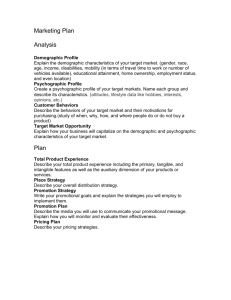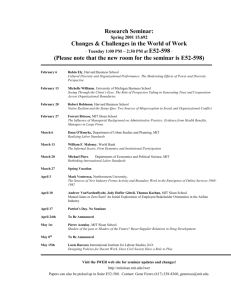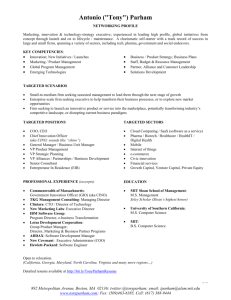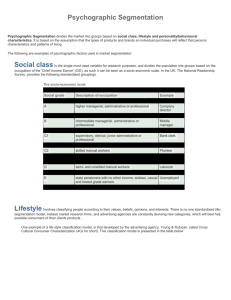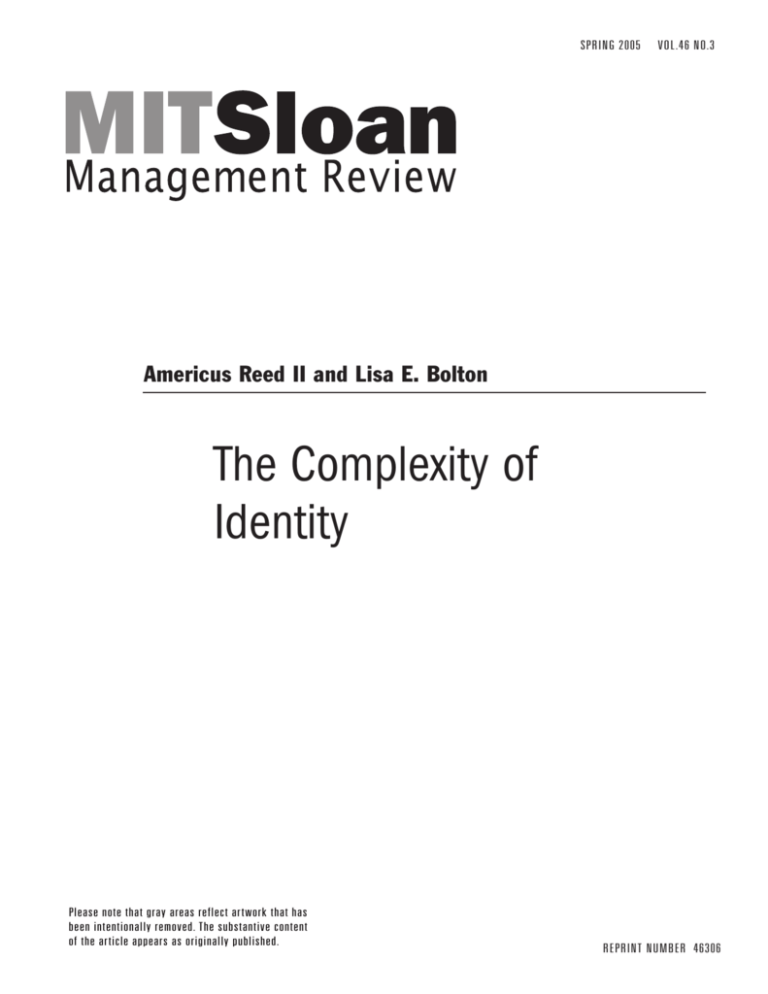
SPRING 2005
VOL.46 NO.3
Americus Reed II and Lisa E. Bolton
The Complexity of
Identity
Please note that gray areas reflect artwork that has
been intentionally removed. The substantive content
of the article appears as originally published.
REPRINT NUMBER 46306
FIELDWORK
The Complexity of Identity
Unlike static
demographic and
psychographic
techniques, identity marketing
taps into the
multilayered and
fluid nature of
who customers
are and who they
want to be.
AMERICUS REED II
AND LISA E. BOLTON
Companies have long
known that people’s sense
of who they are influences their purchase decisions. Even so, the power
of that basic premise has
yet to be exploited fully.
It is not captured by segmentation and targeting
based on easily observable and superficial classifications, such as simple
demographics. Nor is it usually captured by
static, psychographic personality profiles based
on broad lifestyle associations linked to product
categories. Instead, a person’s “identity” is a complex, often fluctuating, deeply enduring aspect of
how that individual sees himself, and the labels
that consumers use to define who they are do not
necessarily correspond to the variables that marketers typically rely on.
Identity marketing, which recognizes the
complex process of how customers become
strongly attracted to the brands and products
that help them to express who they are, is the
next step in the evolution of the field. It is a
potential steppingstone to what is now being
referred to as “cult marketing.” When performed
effectively, it can transform a firm’s brands or
offerings from a mere collection of products into
a deeper constellation of self-embodied lifestyle
symbols. Indeed, identity marketing can enable
organizations to build stronger brands and more
durable customer relationships. But companies
first need to understand the crucial role that
identity plays in their customers’ lives.
What Is Identity?
Identity can be defined as the myriad labels that
people use to express who they are. Consumers
categorize themselves on the basis of demographics, social roles and shared consumption
patterns or preferences. The potential identities
18
MIT SLOAN MANAGEMENT REVIEW
SPRING 2005
that people possess are both numerous and fluid,
varying over an individual’s lifetime and across
situations. In a work setting, for example, a person’s professional identity as an entrepreneur
might be at the top of her mind. Later, at home,
her identity as a parent may move to the forefront. And on the weekends, her identity as an
outdoor enthusiast could take precedent. Identities can be thought of as hats that consumers put
on and take off. Psychographic segmentation
ignores this complexity by assuming the existence of one hat that fits all occasions.
Identity marketing recognizes that customers
are more powerfully attracted to products and
brands that are linked to their multiple identities.
This connection may come about because the
brand symbolizes a customer’s actual identity, but
a brand may also embody an “aspirational identity” — the type of person an individual admires
or wants to become more like. The passion for
Harley-Davidson motorcycles, for instance, is
based on a rebel identity that is aspired to but not
necessarily held by its customers.
To understand some of the concepts of identity marketing, consider how people form attitudes toward hybrid cars. Consumers might
assess the product feature-by-feature, using reasoning that is relatively analytic. Or they might
adopt an environmentalist perspective and review
the product’s attributes in that light. The second
process, called judging from the “inside out,” is
very different from the first, called “outside in.”
Although analytic reasoning is often held up as
the ideal for decision making, research suggests
that identity-driven thinking is more powerful.
For one thing, identity-based judgments are
especially resistant to change because they are
entrenched in people’s views of themselves, which
are shared and reinforced by others. Furthermore,
such attitudes can be complex and multidimensional. Put simply, wearing a hat alters a person’s
viewpoint, affecting how he sees himself, others
Illustration: © Noma/images.com
FIELDWORK
and the world around him. And each hat worn
does so in its own way.
With hybrid cars, the products were initially
positioned around the tangible benefits they provided, including gas-mileage economy and longterm cost effectiveness. More recent marketing has
been oriented toward a customer’s intrinsic concern for the environment and desire for pollutionfree living. Such identity-based images have
Research suggests that an early identity-based
judgment is “sticky.” Initial assumed attitudes tend
persist despite subsequent efforts to reverse them.
subsequently been reinforced by cause-oriented
celebrities and other philanthropic opinion leaders who have chosen to be innovators in adopting
the new technology even in the absence of an
established installed base. And the products themselves have become increasingly stylish. The Toyota Prius has won awards for its sleek design, and
Honda now promotes its Civic Hybrid with the
message, “Get earth-friendly with the sporty Civic
Hybrid — the best of both worlds.” Such multilayered messages have been effective in connecting to
consumers’ different identities, making it smart,
socially responsible and fashionable to drive a
hybrid. In contrast, a conventional demographic
or psychographic approach might have targeted
the cars just toward middle-income parents who
listen to NPR and are concerned about the world
they will leave their children.
Positioning a product around tangible features
or demographic and psychographic segmentation
is a relatively easy thing for competitors to copy.
Identity marketing is not. To be sure, the complexity of identity-based judgments presents
both opportunities and obstacles for marketers,
but companies often fail to appreciate that.
Indeed, many common marketing mistakes can
be traced back to a misunderstanding of customer identity.
Mistake #1: Selling new products solely on their
features. A traditional marketing approach is to
draw people’s attention to tangible features, particularly for new products, and to prompt customers
to make decisions on the basis of this information.
20
MIT SLOAN MANAGEMENT REVIEW
SPRING 2005
Indeed, one popular theory is that brand attitudes
are a function of the importance and value of
brand attributes — and not the other way around.
But in a recent study, consumers were asked to
judge a new electronic book after considering its
features or after adopting the perspective of an
environmentalist. The result: Attitudes based on a
strong environmentalist identity persisted more
than those based on a feature-based analysis of the
product. That is, “who the customer is”
dominated “what the product is.”
The disappointing market performance
of many new products, including
to
e-books, often arises because marketers
emphasize features without linking them
to the identities that matter to consumers.
In contrast, consider how palmOne Inc.’s handheld
devices were successfully positioned as essential
accessories of young, mobile professionals. Indeed,
the bells and whistles of many new products are
important mainly because they are a way for consumers to express their identity — quite literally, in
the case of personalized ring tones and face plates
for cellular phones.
Mistake #2: Failing to solidify first-mover advantage. Companies often rush to market to be the
first with a new product or service. But then they
fail to solidify that advantage by forgetting to link
their brand to customers’ identities. Research
suggests that an early identity-based judgment
is “sticky” — that is, strongly resistant to subsequent counterarguments. In one laboratory
experiment, consumers were asked to consider
the issue of pollution credits from the perspective
of a businessperson. They were then told to consider the opposite viewpoint by assuming the
identity of an environmentalist. The initial
assumed attitudes tended to persist despite the
subsequent efforts to reverse them. In other
words, not only can products themselves have
first-mover advantage, the perspectives they tap
into through identity marketing can also have
that benefit.
One organization that seems particularly adept
at solidifying its market position in that way is
NASCAR Inc. Conventional marketing based on
demographics and psychographics might have
concentrated on blue-collar males who are patriotic, possibly by highlighting the NASCAR
requirement that only American cars are allowed
to compete. But that focus would have missed the
fact that the NASCAR identity of being carefree,
fun and thrill-seeking also appeals to many whitecollar professionals, women and those who are less
jingoistic. To market that aspirational identity to a
broad audience, NASCAR’s Web site includes a
“Travel & Lifestyle” section and highlights the
“Women of NASCAR.” Such efforts have helped
the organization establish itself across demographic and psychographic lines. For instance,
currently 40% of NASCAR attendees are female.
To demonstrate their loyalty, fans readily purchase
products such as T-shirts, hats and jackets with
logos from NASCAR and other sponsoring
brands. In a way, people wear such clothing as a
“badge” that reinforces their identities to the
extent that they cannot conceive of themselves as
whole without the brand.
Mistake #3: Fighting the competition head-on.
But even entrenched organizations like NASCAR
aren’t invulnerable. In fact, one of the advantages
of identity-based marketing is the recognition
that consumers are complex, with numerous
identities that define who they are. For marketers, this complexity provides numerous ways
to position products in order to counter the identity marketing of competitors. One particularly
effective strategy is to avoid head-on attacks and
instead foster attractive alternative identities for
customers.
Consider the antismoking campaign, which
has traditionally emphasized the health and addiction risks of cigarettes. The consensus is that such
appeals have generally been ineffective, particularly in reaching teenagers — a not surprising
result, given the entrenched imagery of smokers as
cool rebels. Thus, recent efforts are instead focusing on creating an alternative identity for young
people, that of the savvy consumer who can’t be
manipulated by the tobacco industry.
Mistake #4: Sticking with what’s worked before.
The multitude of identities that matter to customers, and the many ways that such identities
can be associated with brands, provides ample
opportunity for marketers to stake out a special
position in consumers’ minds. Consider, for
example, the evolution of the erectile-dysfunction
market. The early entry of Viagra was characterized by marketing that tried to communicate
product benefits and overcome reluctance to seek
help, thus the ads with former Sen. Robert Dole.
Those efforts were mainly demographic, concentrating on pre-baby boomers, and psychographic, targeting people who were ill at ease
discussing sexual problems. The later entry of
Cialis and Levitra heightened competitive pressures, with both drugs claiming superior benefits
but also emphasizing the importance of the
product for personal relationships. This reflects
an identity appeal — specifically, being an intimate, thoughtful, loving and romantic partner.
More recently, Pfizer Inc. has responded by
emphasizing how Viagra can restore the vitality
of one’s lost youth, exemplified by the slogan “get
back to the mischief.” Current ads now feature a
handsome, fit man, possibly in his 50s but seemingly in his 40s, with playful devil horns — an
attractive aspirational identity.
Although critics contend that Pfizer may have
gone too far — positioning Viagra around a
youthful, carefree identity might have inadvertently associated the product with recreational use
— the important point is that companies need to
evolve their identity marketing instead of always
sticking with what’s worked before. An example of
a company that was slow to react is McDonald’s
Corp. Even as U.S. consumers became increasingly
health-conscious, the company failed to link its
brand to that identity trend. Instead it offered
“Super Size” portions of its meals, which seemed
to target the company’s traditional demographic
and psychographic base of people with tight
budgets and limited time or desire to cook. Now,
realizing that a healthy lifestyle is important to
consumers, McDonald’s has been touting its salads
and other more nutritious offerings as part of its
“Eat smart, be active” initiative. The company has
thus recognized that the same person can have two
identities that might seem to be mutually exclusive
but aren’t: fast-food consumer and health-conscious individual.
Mistake #5: Underestimating low-involvement
products. Identity marketing can be particularly
important for products that have a complex set of
features. Rather than expending resources to
explain the importance of those features to cusSPRING 2005
MIT SLOAN MANAGEMENT REVIEW
21
FIELDWORK
to reject any outside negativity that was inconsistent with their identity.
Thus, instead of attacking negative word of
mouth, companies might do well to consider ways
to transform it into a positive. The Boston Red Sox
are a good example of how prior product failure,
namely, a World Series drought of 86 years, and
continual criticisms from sportswriters and
naysayers could be deflected by identity
marketing. The Red Sox organization
Demographic and psychographic techniques are too
fostered a mentality of the scrappy
underdog versus the evil, overpaid New
simplistic because consumers have many selves that
York Yankees, and that identity appealed
cannot be easily compressed into neat categories.
enormously to a diehard fan base that
cuts across various demographic and
psychographic segments. The result: lucrative sales
associated with their own political identity and the
of ballpark tickets and merchandise that appeared
values they attributed to either political party.
impervious to whether the team won or lost. In
But identity marketing isn’t just for products
fact, after the Red Sox suffered a crushing defeat to
like cars and financial instruments that might
the Yankees in the 2003 playoffs, ticket sales actuotherwise require sophisticated decision making.
ally increased the following season.
It can also be effective for low-involvement items.
Calvin Klein Inc.’s successful line of men’s underwear is a case in point. Traditionally, demographic
EVERY COMPANY KNOWS that its marketing camand psychographic marketing emphasized just a
paign has to connect with customers, yet many
few features of male undergarments, including
organizations make crucial mistakes in trying to
durability, fit and price, but Calvin Klein mando so. The problem is often a fundamental misunaged to associate its products with an attractive
derstanding of how customers become attracted
aspirational identity: a young, sexy, well-built
to brands, products and consumption behaviors
man. The company also rightly anticipated the
that help them to express who they are. Identity
rise of the “metrosexual,” a phenomenon that
marketing is not just a repackaging of psychoincorporates two seemingly incompatible idengraphic-segmentation techniques, which assume
tities: the heterosexual man and a sophisticated
that people’s stable personality traits can be idenurbanite who spends considerable time and
tified and linked to broad lifestyle orientations
money on his looks.
that can then be classified into general product
classifications. Researchers and practitioners are
now beginning to realize that such approaches are
Mistake #6: Attacking negative word of mouth.
too simplistic because consumers have many
Prior research in marketing has clearly docuselves — some of which might appear to contramented the adverse effects of negative word of
dict each other — that cannot be easily commouth on brand equity. Identity marketing can
pressed into such neat categories.
shield against such damage. In a sense, identity is
an internalized source of social influence, reflectAmericus Reed II and Lisa E. Bolton are assistant
ing beliefs about what others who are similar —
professors of marketing at the Wharton School of the
University of Pennsylvania. They can be reached at
that is, who share the identity — think about a
amreed@wharton.upenn.edu and boltonl@wharton.
product or brand. As such, it can insulate a group
upenn.edu. For additional details on identity marketing,
from conflicts with external sources. In one study,
see the authors’ article “Sticky Priors: The Perseverance
consumers were asked to engage in an online focus
of Identity Effects on Judgment,” Journal of Marketing
group regarding a particular branded product,
Research 41 (2004): 397-410.
and the participants were then exposed to social
Reprint 46306. For ordering information, see page 1.
influences from outsiders. Not surprisingly, people
Copyright © Massachusetts Institute of Technology, 2005. All
who strongly identified with the brand were likely
rights reserved.
tomers, a company might be better off linking the
product to an identity that already matters to
them. Consider, for example, the formation of
political attitudes in the 2004 U.S. presidential
race. If asked, most of the voting public would
have been hard pressed to articulate details regarding the candidates’ platforms. Instead, people’s
decisions seemed to reflect an emotional response
22
MIT SLOAN MANAGEMENT REVIEW
SPRING 2005
PDFs ■ Reprints ■ Permission to Copy ■ Back Issues
Electronic copies of MIT Sloan Management Review
articles as well as traditional reprints and back issues can
be purchased on our Web site: www.sloanreview.mit.edu
or you may order through our Business Service Center
(9 a.m.-5 p.m. ET) at the phone numbers listed below.
To reproduce or transmit one or more MIT Sloan
Management Review articles by electronic or mechanical
means (including photocopying or archiving in any
information storage or retrieval system) requires written
permission. To request permission, use our Web site
(www.sloanreview.mit.edu), call or e-mail:
Toll-free in U.S. and Canada: 877-727-7170
International: 617-253-7170
e-mail: smrpermissions@mit.edu
To request a free copy of our article catalog,
please contact:
MIT Sloan Management Review
77 Massachusetts Ave., E60-100
Cambridge, MA 02139-4307
Toll-free in U.S. and Canada: 877-727-7170
International: 617-253-7170
Fax: 617-258-9739
e-mail: smr-orders@mit.edu
Reproduced with permission of the copyright owner. Further reproduction prohibited without permission.

